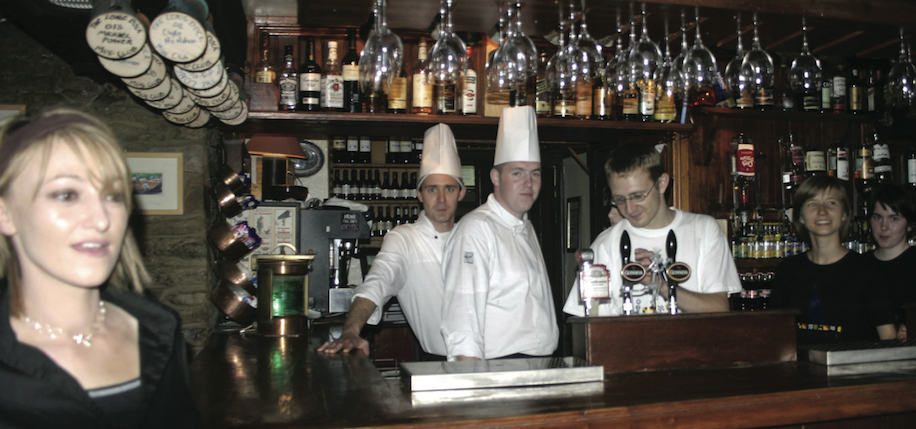Last year they opened a new Irish pub on Main Street here [Milford, Michigan]. O’Callaghan’s they call it, and it’s owned by two Palestinians who did it up in high Paddy style, with snugs and dark hardwoods, Guinness and designer lagers and a couple of imported boyos behind the bar. The décor came from Dublin in a kit. The lads came on their own from Wexford to pull pints, pour shots and give out with the brogue-y chat that separates an Irish pub from every other kind.
Market research has shown that suburban Americans, like Parisians and the Japanese, find getting a little tipsy in an Irish bar is more agreeable – kinder, gentler, cuter somehow – than the shot and beer dispensaries where sad men sip up their sedation in privacy and silence. Folksy calls of “Slainte!” and “Failte!”, a dart board on the premises, some blarney and stews and beer-battered fish, tin whistles and a table quiz, a big screen with hurling or rugby games all conspire to make the consumption of fermented depressants anything but depressing.
It is an illusion, of course, a faux reality, but it’s market savvy, and the Palestinians are packing them in. How very Disney, I say to myself, how very American – like going to Vegas to experience Venice, a kind of dude ranch for the wannabe “faith and begorrah” sorts.
But in West Clare, where I summer in the ancestral cottage that was left to me, between the North Atlantic and the River Shannon’s mouth, the authentics and realities are shifting too. My local is the Long Dock in Carrigaholt, an estuarial village of 600 with a castle, a small fishing fleet and an influx of seasonal visitors. It’s the real thing, the Long Dock, a genuine Irish pub with turf and flagstones, Armitage Shanks urinals and a history of famines and festivities. I’ve been going there for decades now, and though I quit the “top shelf” and pints years back, I love the fresh catch and local chowder, the company of friends and strangers.
Though the Long Dock is owned by a family named Lynch, two Lithuanians work the bar, a pair of Poles wait tables, and Latvians in the kitchen turn out continental versions of the local fare. They come for Easter and stay till summer’s end, returning home flush with money the way poor local farmers, a generation back, used to winter in Glasgow and Liverpool and London, working to keep body and soul together.
Like the young of Carrigaholt and its surrounding towns, the young of Krakow and Vilnius are coming and going as they please now, citizens of the European Union and the global villages. Bartenders without borders, they travel light between cultures, common markets and currencies, picking up the languages, finding in the eyes of strangers the shared lights of humanity.
In this they resemble St. Patrick himself. The son of Romans stationed in Britain, he was kidnapped in his youth by marauding Irish who sold him into slavery to a Druid master. Given to visions and important dreams, after years of contemplative indenture tending sheep, he got free of his captors, took Holy Orders in France, thence to Rome where he was given his mission: to return and convert the “pagan” Irish from their worship of nature and its elements. It was early in the fifth century, and the sun and the yew tree and the river all seemed sacred still.
The local holy men were unenthusiastic about Patrick’s zeal and brought their own powers to bear against him. Still the Irish became, in the fullness of time, according to the ancient texts, “docile to the faith.” It helped that Patrick was a deft metaphorist and could bridge the gaps between beliefs, finding connections in what seemed disparate themes. The Celtic cross was one such compromise – Patrick’s overlay of the circular symbol of the rising sun (a god in Druid theology) to the cruciform of the Christian’s risen son of God. Both were signs of second chances. Then there was the shamrock, which the saint famously used to explain the Trinity – that mystery of the many and the one, of unity’s embrace of diversity. The man had a knack for difficult mysteries, for sorting the sames and differents.
And here are some more glorious and sorrowful mysteries: how race and nation, faith and place, define and divide us endlessly; how ethnicity makes fast friends of strangers and also poisons the well of humanity; how religion calls us to worship and so miscalculates our Gods. If there is only one God – as all Muslims, Christians and Jews believe – then isn’t the one we believe in one and the same? If there is no God, aren’t we off only by one? And if there are many, aren’t there plenty to go around? Consider the shamrock. Consider those famous 40 shades of green Ireland is said to have. It’s Disney, an illusion, a fake Irish bar. The world we live in is 40 shades of gray, and in each of them still 40 more.
The barkeepers know this in Milford and West Clare, in Boston and Baghdad, in Dublin and Darfur, wherever they are – it’s always the same human thirst and hunger, the same longing for the shared feast and safe harbor, the home fire and known place, the common table and place at the bar. The green beer and blather, the old songs and good craic notwithstanding, until all are safe in their own place, a Great Day for the Irish, or the Americans, is just pretend.
Thomas Lynch is the author of several books including, most recently, Booking Passage: We Irish and Americans. ♦


Leave a Reply